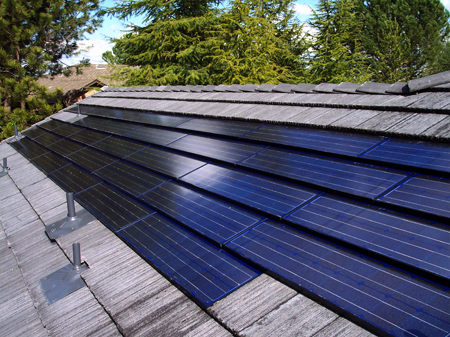Not crazy about the idea of a solar array on the roof of your log home? Building-integrated photovoltaics (BIPV) are designed to replace standard construction materials with PV systems that produce clean energy, increase home value, and protect the environment. BIPV is not added to the home, but is an integral part of its structure. For example, instead of putting a typical roof on your home and adding a solar array on top of it, the roofing material becomes the solar collector.
There are two basic types of PV roofing: standing seam metal and solar tiles or shingles. For the metal roofing, a thin layer of PV laminate is applied directly to the metal roof panels. The roof is then installed using standard roofing techniques. Once the roof is on, the PV contractor provides the rest of the system’s elements and gets it up and running.
Solar tiles and shingles can be integrated into almost any style of roof, from asphalt shingles to concrete tile, even to slate. Some cover the entire roof and others are inserted in sections on the roof. Most can be installed using standard roofing methods, while a PV contractor connects your solar-collecting tiles to the rest of the system.
There are multiple advantages: your roof becomes your PV power generator but looks just like a standard metal or tile roof; it can be installed using traditional methods; no support structures are needed on the roof; the roof can withstand high winds and hail and is weather-tight; and the installation is cost-effective—you are installing one system instead of two.
On the Horizon: MIT recently developed solar concentrators that harvest light from window glass and gather it at the edges of the window. Dyes that absorb light across a wide range of wavelengths are painted on the piece of glass or plastic. The energy pushed to the edge of the widow is then stored in solar cells. Today, this technology is primarily used in commercial buildings, but it won’t be long before PV windows are available for home installation.

